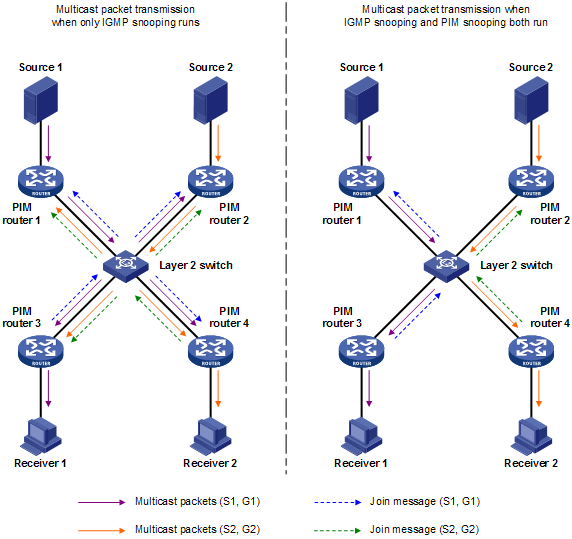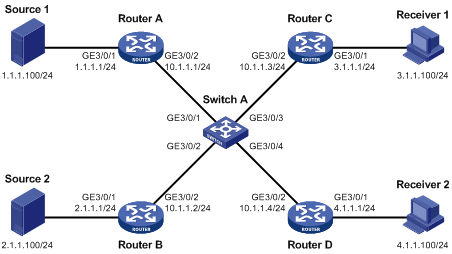- Table of Contents
-
- 08-IP Multicast Configuration Guide
- 00-Preface
- 01-Multicast Overview
- 02-IGMP Snooping Configuration
- 03-PIM Snooping Configuration
- 04-Multicast VLAN Configuration
- 05-Multicast Routing and Forwarding Configuration
- 06-IGMP Configuration
- 07-PIM Configuration
- 08-MSDP Configuration
- 09-MBGP Configuration
- 10-Multicast VPN Configuration
- 11-MLD Snooping Configuration
- 12-IPv6 PIM Snooping Configuration
- 13-IPv6 Multicast VLAN Configuration
- 14-IPv6 Multicast Routing and Forwarding Configuration
- 15-MLD Configuration
- 16-IPv6 PIM Configuration
- 17-IPv6 MBGP Configuration
- Related Documents
-
| Title | Size | Download |
|---|---|---|
| 03-PIM Snooping Configuration | 141.62 KB |
Contents
Configuring PIM snooping································································································································································ 1
Overview······················································································································································································ 1
Configuring PIM snooping······················································································································································ 2
Displaying and maintaining PIM snooping························································································································ 3
PIM snooping configuration example·································································································································· 3
Troubleshooting PIM snooping··············································································································································· 6
PIM snooping does not work········································································································································· 6
Some downstream PIM-capable routers cannot receive multicast data···························································· 6
Overview
Protocol Independent Multicast (PIM) snooping runs on Layer 2 devices. It determines which ports are interested in multicast data by analyzing the received PIM messages, and adds the ports to a multicast forwarding entry to make sure that multicast data can be forwarded to only the ports that are interested in the data.
Figure 1 Multicast packet transmission without or with PIM snooping

As shown in Figure 1, Source 1 sends multicast data to multicast group G1, and Source 2 sends multicast data to multicast group G2. Receiver 1 belongs to G1, and Receiver 2 belongs to G2. The Layer 2 switch's interfaces that connect to the PIM-capable routers are in the same VLAN.
· When running IGMP snooping without PIM snooping, the Layer 2 switch maintains the router ports according to PIM hello messages received from PIM-capable routers, broadcasts all other types of received PIM messages in the VLAN, and forwards all multicast data to all router ports in the VLAN. Each PIM-capable router in the VLAN, whether interested in the multicast data or not, will receive all multicast data and all PIM messages except for PIM hello messages.
· When running both IGMP snooping and PIM snooping, the Layer 2 switch determines whether PIM-capable routers are interested in the multicast data addressed to a multicast group according to PIM messages received from the routers, and adds only the ports for connecting the routers that are interested in the data to a multicast forwarding entry. Then, the Layer 2 switch forwards PIM messages and multicast data to only the routers that are interested in the data, saving network bandwidth.
The term "router" in this document refers to both routers and Layer 3 switches.
For more information about IGMP snooping and the router port, see "Configuring IGMP snooping."
For more information about PIM, see "Configuring PIM."
Configuring PIM snooping
When you configure PIM snooping, follow these guidelines:
· Before configuring PIM snooping for a VLAN, be sure to enable IGMP snooping globally and specifically for the VLAN.
· After you enable PIM snooping in a VLAN, PIM snooping works only on the member interfaces of the VLAN.
· PIM snooping does not take effect on the sub-VLANs of a multicast VLAN.
|
Step |
Command |
Remarks |
|
1. Enter system view. |
system-view |
N/A |
|
2. Enable IGMP snooping globally and enter IGMP-snooping view. |
igmp-snooping |
Disabled by default. |
|
3. Return to system view. |
quit |
N/A |
|
4. Enter VLAN view. |
vlan vlan-id |
N/A |
|
5. Enable IGMP snooping in the VLAN. |
igmp-snooping enable |
Disabled by default. |
|
6. Enable PIM snooping in the VLAN. |
pim-snooping enable |
Disabled by default. |
For more information about multicast VLAN, see "Configuring multicast VLANs."
Displaying and maintaining PIM snooping
|
Command |
Remarks |
|
|
Display PIM snooping neighbor information (in standalone mode). |
display pim-snooping neighbor [ vlan vlan-id ] [ slot slot-number ] [ | { begin | exclude | include } regular-expression ] |
Available in any view. |
|
Display PIM snooping neighbor information (in IRF mode). |
display pim-snooping neighbor [ vlan vlan-id ] [ chassis chassis-number slot slot-number ] [ | { begin | exclude | include } regular-expression ] |
Available in any view. |
|
Display PIM snooping routing entries (in standalone mode). |
display pim-snooping routing-table [ vlan vlan-id ] [ slot slot-number ] [ | { begin | exclude | include } regular-expression ] |
Available in any view. |
|
Display PIM snooping routing entries (in IRF mode). |
display pim-snooping routing-table [ vlan vlan-id ] [ chassis chassis-number slot slot-number ] [ | { begin | exclude | include } regular-expression ] |
Available in any view. |
|
Display statistics for the PIM messages learned by PIM snooping. |
display pim-snooping statistics [ | { begin | exclude | include } regular-expression ] |
Available in any view. |
|
Clear statistics for the PIM messages learned by PIM snooping. |
reset pim-snooping statistics |
Available in user view. |
PIM snooping configuration example
Network requirements
As shown in Figure 2, Source 1 sends multicast data to multicast group 224.1.1.1, and Source 2 sends multicast data to multicast group 225.1.1.1. Receiver 1 belongs to multicast group 224.1.1.1, and Receiver 2 belongs to multicast group 225.1.1.1. Router C and Router D run IGMP on their interface GigabitEthernet 3/0/1. Router A, Router B, Router C, and Router D run PIM-SM, and interface GigabitEthernet 3/0/2 on Router A acts as a C-BSR and C-RP.
Configure IGMP snooping and PIM snooping on Switch A so that Switch A forwards PIM messages and multicast data to only the routers that are interested in the multicast data.

Configuration procedure
1. Configure an IP address and subnet mask for each interface according to Figure 2. (Details not shown.)
2. On Router A, enable IP multicast routing, enable PIM-SM on each interface, and configure interface GigabitEthernet 3/0/2 as the C-BSR and the C-RP.
<RouterA> system-view
[RouterA] multicast routing-enable
[RouterA] interface GigabitEthernet 3/0/1
[RouterA-GigabitEthernet3/0/1] pim sm
[RouterA-GigabitEthernet3/0/1] quit
[RouterA] interface GigabitEthernet 3/0/2
[RouterA-GigabitEthernet3/0/2] pim sm
[RouterA-GigabitEthernet3/0/2] quit
[RouterA] pim
[RouterA-pim] c-bsr GigabitEthernet 3/0/2
[RouterA-pim] c-rp GigabitEthernet 3/0/2
3. On Router B, enable IP multicast routing, and enable PIM-SM on each interface.
<RouterB> system-view
[RouterB] multicast routing-enable
[RouterB] interface GigabitEthernet 3/0/1
[RouterB-GigabitEthernet3/0/1] pim sm
[RouterB-GigabitEthernet3/0/1] quit
[RouterB] interface GigabitEthernet 3/0/2
[RouterB-GigabitEthernet3/0/2] pim sm
4. On Router C, enable IP multicast routing, enable PIM-SM on each interface, and enable IGMP on GigabitEthernet 3/0/1.
<RouterC> system-view
[RouterC] multicast routing-enable
[RouterC] interface GigabitEthernet 3/0/1
[RouterC-GigabitEthernet3/0/1] pim sm
[RouterC-GigabitEthernet3/0/1] igmp enable
[RouterC-GigabitEthernet3/0/1] quit
[RouterC] interface GigabitEthernet 3/0/2
[RouterC-GigabitEthernet3/0/2] pim sm
5. Enable IP multicast routing, PIM-SM, and IGMP on Router D in the same way. (Details not shown.)
6. Configure Switch A:
# Enable IGMP snooping globally.
<SwitchA> system-view
[SwitchA] igmp-snooping
[SwitchA-igmp-snooping] quit
# Create VLAN 100, assign GigabitEthernet 3/0/1 through GigabitEthernet 3/0/4 to this VLAN, and enable IGMP snooping and PIM snooping in the VLAN.
[SwitchA] vlan 100
[SwitchA-vlan100] port GigabitEthernet 3/0/1 to GigabitEthernet 3/0/4
[SwitchA-vlan100] igmp-snooping enable
[SwitchA-vlan100] pim-snooping enable
[SwitchA-vlan100] quit
Verifying the configuration
# On Switch A, display the PIM snooping neighbor information of VLAN 100.
[SwitchA] display pim-snooping neighbor vlan 100
Total number of neighbors: 4
VLAN ID: 100
Total number of neighbors: 4
Neighbor Port Expires Option Flags
10.1.1.1 GE3/0/1 02:02:23 LAN Prune Delay
10.1.1.2 GE3/0/2 03:00:05 LAN Prune Delay
10.1.1.3 GE3/0/3 02:22:13 LAN Prune Delay
10.1.1.4 GE3/0/4 03:07:22 LAN Prune Delay
The output shows that Router A, Router B, Router C, and Router D are PIM snooping neighbors.
# On Switch A, display the PIM snooping routing information of VLAN 100.
[SwitchA] display pim-snooping routing-table vlan 100
Total 2 entry(ies)
FSM Flag: NI-no info, J-join, PP-prune pending
VLAN ID: 100
Total 2 entry(ies)
(*, 224.1.1.1)
Upstream neighbor: 10.1.1.1
Total number of downstream ports: 1
1: GE3/0/3
(*, 225.1.1.1)
Upstream neighbor: 10.1.1.2
Total number of downstream ports: 1
1: GE3/0/4
The output shows that Switch A will forward the multicast data intended for multicast group 224.1.1.1 to only Router C, and forward the multicast data intended for multicast group 225.1.1.1 to only Router D.
Troubleshooting PIM snooping
PIM snooping does not work
Symptom
PIM snooping does not work on the switch.
Analysis
IGMP snooping or PIM snooping is not enabled on the switch.
Solution
1. Use the display current-configuration command to determine the status of IGMP snooping and PIM snooping.
2. If IGMP snooping is not enabled, enter system view and use the igmp-snooping command to enable IGMP snooping globally. Then, enter VLAN view and use the igmp-snooping enable and pim-snooping enable commands to enable IGMP snooping and PIM snooping in the VLAN.
3. If PIM snooping is not enabled, enter VLAN view and use the pim-snooping enable command to enable PIM snooping in the VLAN.
Some downstream PIM-capable routers cannot receive multicast data
Symptom
In a network with fragmented join/prune messages, some downstream PIM-capable routers cannot receive multicast data.
Analysis
PIM snooping cannot reassemble messages, and it cannot maintain the status of downstream routers that the join/prune message fragments carry. To ensure the normal operation of the system, PIM snooping must broadcast join/prune message fragments in the VLAN. However, if the VLAN has a PIM-capable router that has the join suppression function enabled, the broadcast join/prune message fragments might suppress the join messages of other PIM-capable routers in the VLAN. As a result, some PIM-capable routers cannot receive the multicast data destined for a specific multicast group because their join messages are suppressed. To solve this problem, disable the join suppression function on all PIM-capable routers that connect to the PIM snooping-capable switch in the VLAN.
Solution
1. Use the pim hello-option neighbor-tracking command to enable the neighbor tracking function on the interfaces of PIM routers that connect to the PIM snooping-capable switch.
2. If a PIM-capable router cannot be enabled with the neighbor tracking function, you have to disable PIM snooping on the switch.

